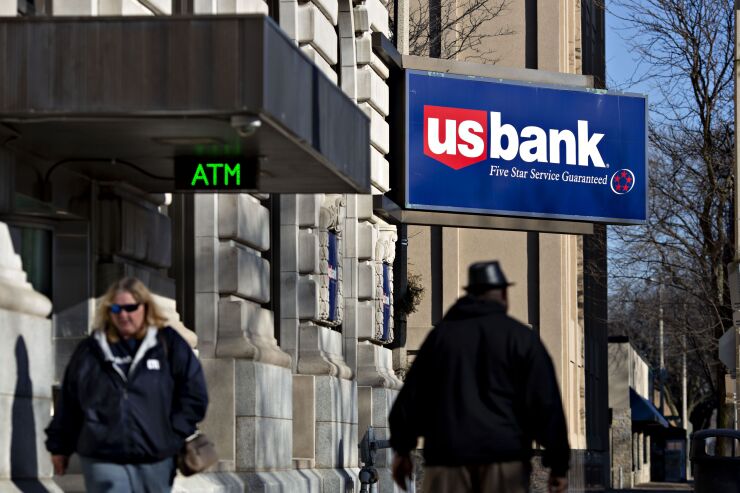
With two major real-time payment networks now available in the U.S. following FedNow's launch, financial institutions are
These decisions must come even as most banks are still connecting to
"Most of our clients are familiar with the concept of immediate payments," said Jennifer Barker, global head of treasury services for Bank of New York Mellon. "The main question is the right use."
Getting paid
BNY Mellon, which is one of the more than 50 banks, credit unions and financial technology companies that were
Employers that are paying a worker the same day as their work was performed can reduce the costs associated with alternatives such as prepaid cards and minimize delays for checks or automated clearing house payments, according to the bank. This can be a potential benefit in a tight labor market in which many businesses still face
"In a tight labor market, how often you get paid is a major opportunity," Barker said. "It's a big advantage to get paid regularly."
BNY Mellon is also focused on consumer and business bill payment, viewing real-time settlement as another way to shed paper checks and manage supply chains. The bank is selling payees on the ability to receive funds instantly, rather than the typical three to seven days. Real-time billing has existed for years;

"Not every financial institution has joined the RTP rail, or has connected to real-time pay," Barker said. "There's a variety of reasons. They don't have the right tech. Or they could [have been] waiting for FedNow."
Banks can use real-time payments as a way to do more bill payment processing in-house, speeding account funding and reducing back-office complexity, according to Joshua Siegel, a partner at Capco. "It's really now a matter of banks prioritizing which uses should come first," Siegel said.
Which way?
Beyond the actual speed of the payment, U.S. Bank is focused on data management, or the information that accompanies a transaction, and how that is managed in a market that includes both FedNow and the RTP network. The Minneapolis bank does not endorse either rail in client dealings but instead offers access to both rails and other digital payment options as part of a menu.
The bank's view is that consumers and businesses will use multiple options and may switch between payment types based on the timing of the transaction or the consumer's economic position.
To manage this, U.S. Bank has developed what it calls intelligent routing. The bank automatically fields instructions from clients and bases a recommendation for a payment option based on a particular set of needs, balancing settlement time and expense.
"The more choices that there are, the more complex it is for clients," said Anu Somani, head of global payments and embedded payments at U.S. Bank. "They don't want to deal with lots of formats. They just want to know if it's cost-effective and if it fits their business goals."
U.S. Bank's intelligent routing is a form of payments orchestration. It is a relatively new concept, at least in an automated digital form. While few companies offer intelligent payment routing on a large scale,
U.S. Bank's intelligent routing could serve as a bank-operated option for payments orchestration.
"We really are spending more time on payments orchestration," said Spencer Hurst, a vice president at Lovell Minnick, adding that his firm has invested in Fortis and Engage, firms that offer related technology. "It's a newer buzzword. But it's really a strong connection layer to route payments quickly."
Since FedNow and RTP are not interoperable, and real-time payments will not be used in all cases, payment companies have an opportunity to sell a service that can route transactions through the right rail.
"We anticipate a multirail environment for the foreseeable future. Companies will use instant payment rails along with ACH to meet different needs," said Ajay Andrews, payments and identity product lead at Plaid, a data-aggregation company that powers open-banking technology, connecting banks to more than 8,000 fintechs.
Plaid has anticipated FedNow by making the account-verification and risk products that support ACH transactions available for FedNow.
Shortly before FedNow launched, Plaid added instant payouts to its transfer product, which enables business-to-consumer payments in real time for loan payments, insurance transactions, wage disbursements and other use cases.
As RTP and FedNow increase bank coverage and support more functionality, the use of instant rails will increase, Andrews said. "Ultimately companies will use the optimal rail for specific use cases and providers like Plaid will remove complexity for both companies and their customers."
Risk
The institutions that are using real-time payments are also updating technology to mitigate the threat of fraud due to shorter processing windows.
At U.S. Bank, real-time payment users are screened and vetted beforehand, and the bank also identifies whether the beneficiary's bank is enabled to securely receive funds in real time.
"We were involved with the RTP platform early on, and a lot of learnings have gone into how we're working with FedNow," said Alberto Casas, executive vice president and head of global treasury management at U.S. Bank.
There is also the potential for run risk.
"In other countries where we have worked on instant payments, like India, Brazil or the U.K., we have not seen this as a fundamental risk," said Bridget Hall, who is on the solutions leadership team for real-time payments at ACI Worldwide. "There will be changes that need to be put in place to ensure there is liquidity, but there are other controls, such as the limits."
FedNow's transfer limit is $500,000 and the RTP rail's limit is $1 million, though banks can lower these limits or set other parameters. "And the adoption of FedNow will likely be in a phased approach," Hall said.
U.S. Bank and BNY Mellon's execs said they were not concerned about run risk. U.S. Bank's Casas said money moves faster via real-time payments, but with the same controls as other options.
'"Instant payments already exist in the RTP network. So we don't see a run risk," Barker said, noting that there are transaction size limits for both RTP and FedNow.
The interviews with U.S. Bank and BNY Mellon were done before Moody's Aug. 8 downgrade of several banks. U.S. Bank and BNY Mellon were among the banks Moody's






